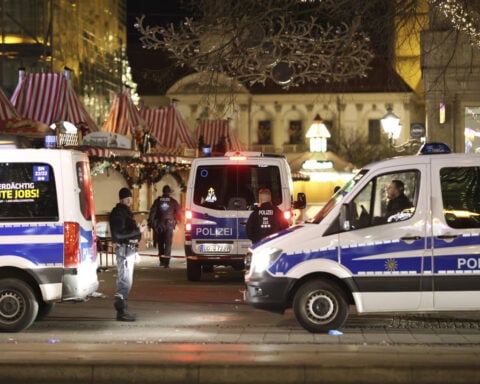The seemingly endless cycle of reforms in juvenile justice
On Sep. 3, Ohio Gov. Mike DeWine announced that the state will try to shut down its three large youth correctional facilities in favor of building smaller and less centralized units. DeWine cited findings that young people "do not respond well to adult-style incarceration," Crain's Cleveland Business reported. The Marshall Project examines the situation and its circumstances further.
The decision came at the urging of a working group assembled by the governor that also recommended the state stop incarcerating teenagers convicted for the first time of non-violent crimes and children under 14 in state youth prisons.
The working group was assembled after a months-long investigation into Ohio's juvenile justice system by several local newspapers. The investigation found that youths in the system were routinely victims of violence and neglect, and that employees of the facilities faced chronic understaffing and threats to their safety. Instead of receiving rehabilitation and support, many of these young people left the system with trauma that exacerbated behavioral issues. Teens who enter the system have a 40% likelihood of winding up back in custody and face a disproportionate chance of dying an early, violent death.
Los Angeles County may serve as a cautionary tale for Ohio. Four years ago, the county's own juvenile justice working group made similar proposals in a plan called "Youth Justice Reimagined." Like in Ohio, one of the centerpieces of the reform was to decentralize the county's juvenile halls and replace them with "smaller, more homelike 'safe and secure healing centers,'" according to the Pasadena Star-News.
Then, last year the county reopened the previously shuttered Los Padrinos Juvenile Hall, reasoning that consolidating youths into the facility would let the county system operate more efficiently. Officials are still trying to lower the number of young people at the hall, but violence and drugs have proliferated, youths report feeling unsafe and the threat of another shutdown looms constantly.
Understaffing is one of the most pervasive issues in juvenile justice across the nation, and officials in charge of some systems—like Los Padrinos—have been pulling public servants from other jobs and departments to fill the gaps.
At Los Padrinos, even after 100 field officers from the county's adult probation program were ordered to work shifts at the hall, staffing levels were still routinely below the legal minimum in July. The low staffing levels are largely related to employees calling out of shifts at a rate that officials have called "extraordinary."
It's a vicious cycle. Staff miss work due to "low morale, increased violence, and worries about excessively long shifts," Probation Oversight Commissioner Sean Garcia-Leys told the Pasadena Star-News' Jason Henry. The lack of sufficient staff then exacerbates those poor working conditions.
In Washington state, Gov. Jay Inslee recently ordered 20 adult corrections employees to work shifts at one juvenile detention center, under an emergency protocol.
The mother of an incarcerated child expressed mixed feelings about the move. She was hopeful that the new staff might bring skills to help the facility operate. But, she asked the Washington State Standard, "They're used to dealing with adults. This is supposed to be a different form of incarceration. So are they equipped to be dealing with youth?"
In Wisconsin, juvenile justice workers are seeking access to tools used in the adult criminal justice system to manage behavior after a youth counselor was killed in an alleged assault by a 16-year-old earlier this summer. In interviews with a court-appointed monitor, staff claimed "there was no way to hold the youth responsible for their behavior without pepper spray, solitary confinement, and mechanical restraints," according to reporting from the Milwaukee Journal Sentinel.
Those practices were all banned under a 2018 settlement after young people in state facilities alleged a pattern of brutality and neglect. The state's Democratic governor and Republican members of the legislature have been at odds over whether to walk back some of the restrictions in the settlement. But late last month, a judge ruled that they would remain in place.
Meanwhile, a new restriction on the use of solitary confinement was adopted at the Manson Youth Institution in Connecticut after an inquiry launched by the Department of Justice's Civil Rights Division.
"We know that isolation can cause real harm to children—increasing risk of depression, anxiety, self-harm, and suicide—because their brains are still developing and they lack adequate coping mechanisms," said Assistant Attorney General Kristen Clarke in a Justice Department statement announcing the agreement.
Clarke's civil rights division has also opened an investigation into Kentucky's juvenile justice system. That move followed a state auditor report earlier this year, and the findings included the mistreatment of children, high rates of pepper spray use, and the punitive use of solitary confinement.
That investigation looms as the state prepares to reopen a detention center in Louisville, the state's largest city. The detention center has been closed since 2019 amid a budgetary battle between the city and state, which ultimately led to a plan to refurbish the facility.
Juanisha Saunders, whose son spent time in Kentucky's juvenile justice system, expressed cautious optimism to the Louisville Courier-Journal. She said a well-run center could help some young people change their lives. But, she cautioned against cosmetic changes that don't address core issues. "You can slap a coat of paint on it," she told the paper, "but if you don't change the inside, it's still going to become the same."

 How to save a fentanyl victim: Key facts about naloxone
How to save a fentanyl victim: Key facts about naloxone
 Eight convicted in France over murder of teacher who showed Prophet caricature
Eight convicted in France over murder of teacher who showed Prophet caricature
 Death toll from German Christmas market car-ramming rises to four, Bild reports
Death toll from German Christmas market car-ramming rises to four, Bild reports
 France's Mayotte struggles to recover as cyclone overwhelms hospitals
France's Mayotte struggles to recover as cyclone overwhelms hospitals
 Russia's UK embassy denounces G7 loans to Ukraine as 'fraudulent scheme'
Russia's UK embassy denounces G7 loans to Ukraine as 'fraudulent scheme'
 Pope calls Gaza airstrikes 'cruelty' after Israeli minister's criticism
Pope calls Gaza airstrikes 'cruelty' after Israeli minister's criticism
 Retailer Party City files for bankruptcy, will wind down 700 stores
Retailer Party City files for bankruptcy, will wind down 700 stores
 Soccer's top players have had enough, as FIFA's new super-sized tournament sparks a revolt
Soccer's top players have had enough, as FIFA's new super-sized tournament sparks a revolt
 Lindsey Vonn finishes 14th in a super-G to mark her return to World Cup skiing at age 40
Lindsey Vonn finishes 14th in a super-G to mark her return to World Cup skiing at age 40
 Santa and Mrs. Claus use military transports to bring Christmas to an Alaska Native village
Santa and Mrs. Claus use military transports to bring Christmas to an Alaska Native village








